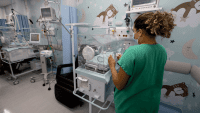Take advantage of their expertise to support patient care and research.
- Nurse scientists help bridge interdisciplinary gaps in clinical research and practice to enhance the reliability and safety of patient care.
- Despite their critical role, their presence in clinical settings remains underutilized, a gap that signifies missed opportunities for advancing patient care through research and evidence-based practices.
- A research culture that integrates technology, patient experience, and provider expertise will create a paradigm shift and robust infrastructure for healthcare organizations.
According to studies by Allen and Brant, nurse scientists play a pivotal role in bridging interdisciplinary gaps in clinical research and practice to enhance patient care reliability and safety. Nurse scientists, with their advanced degrees and training in clinical research, stand at the forefront of integrating scientific inquiry with clinical practice, aiming to enhance patient outcomes and propel healthcare forward. However, according to Mu and colleagues, these professionals remain underused in clinical settings, a gap that signifies missed opportunities for advancing patient care.
The American Association of Colleges of Nursing (AACN) and the American Organization for Nursing Leadership have outlined guiding principles for academic–practice partnerships (APPs), including knowledge sharing and joint research. AACN’s report emphasizes investment in nursing research and its translation into practice, recognizing the crucial role of these partnerships. Nurse scientists with PhD or doctor of nursing practice (DNP) degrees empower clinicians to understand the impact of research on healthcare delivery, policy, workforce management, and technology integration.
Engaging nurses in scholarly work
Nurse-scientists and nurse-engineers
Nurse scientist contributions
Polomano and colleagues emphasized the significant contributions nurse scientists make in developing new knowledge, designing evidence-based health policies, and facilitating grant funding. Their role in translating research findings into clinical practice improves patient outcomes and advances system-wide healthcare improvements. Nurse scientists’ expertise allows them to blend clinical acumen with research, creating a potential paradigm shift in patient care and research integration.
The advancement in evidence-based practice, quality improvement, and healthcare research hinges on collaborative efforts across all disciplines, and nurse scientists or clinician-scientists help drive cultural shifts toward quality, safety, and innovation. These shifts aim to enhance patient outcomes, ensure cost-effectiveness, and inform clinical decisions.
The American Nurses Association and Kawar and colleagues noted that nurses lead projects related to patient safety and quality care, contributing to both tangible and nontangible returns on investment, thereby enhancing operational efficiency and financial stability. In commenting on the challenges of securing funding and balancing research with clinical responsibilities, Lauck and colleagues advocated for interprofessional team approaches that involve senior leadership, nursing, provincial government policymakers, and APPs to help sustain the scientific rigor of evidence-based practice.
The 2010 Future of Nursing: Leading Change, Advancing Health report called for more faculty, scientists, and researchers. In addition, the ANCC Magnet Recognition Program® emphasizes five components (new knowledge, innovation, exemplary professional practice, structural empowerment, and empirical outcomes) designed to prompt initiatives that maintain and sustain the integration of nurse scientists into healthcare organizations and are realized through nurses’ evidence-based projects. The implications of achieving and sustaining Magnet® recognition epitomizes the gold standard of nursing excellence, nurse retention, staff satisfaction, improved safety, and quality patient outcomes.
Challenges on the frontline
According to Hickey, inter- and transprofessional revolutions in scientific research aimed at ensuring holistic care requires leveraging nurse scientists in both academic and clinical settings. Polomano and colleagues noted the need for restructured PhD programs to better prepare nurse scientists for their roles in patient health, workforce, and policy development. Diverse nurse scientist engagement includes working with patients, families, clinicians, policymakers, and researchers, thus transcending traditional academic boundaries.
The nursing profession has received grant funding from the National Institutes of Health (NIH) and various organizations for research, including partnerships with other scientific fields. However, Bloch and Glasgow reported that the COVID-19 pandemic has resulted in a shortage of senior nurse scientists with clinical expertise, which creates challenges to obtaining funding. Research advancement requires that we sustain and replenish this funding. Mu and colleagues’ cross-sectional study of nurse scientists in the Veterans Health Administration confirmed the connection between a strong research infrastructure and higher research productivity and funding.
Brant focused on the integration of nurse scientists in facilitating evidence-based practice and expanding research mentoring in clinical settings. For example, the doctoral nurse advisory board (DNAB), established in 2023 at Hackensack Meridian Health (HMH), aims to revitalize nursing research and bridge generational gaps through mentorship and the use of a Donabedian model to engage frontline clinicians and key stakeholders. (See Nurse scientist success.)
Nurse scientist success
Historically, Magnet® designation recognizes healthcare organizations for nursing excellence and highlights the use of nurse scientists in facilitating a research-rich infrastructure. In the Hackensack Meridian Health (HMH) network, eight nurse scientists support research across 11 campuses, collaborating with healthcare professionals to drive innovation and solve problems. However, engaging frontline clinicians in research remains a challenge.
Executive leadership support contributes to the success of initiatives that promote personal and professional development of frontline clinicians through formal mentorship. HMH promotes multidisciplinary collaboration among nurse scientists from the Ann May Center for Nursing and Allied Health, the office of research administration, the quality improvement department, the center for discovery and innovation, the diversity, equity and inclusion initiatives, and various team member resource groups. Through coordinated efforts with the nurse scientists and professional development workshop taskforce, the learning management system department used an algorithm to match experts with professional and nonprofessional members. Through formal mentorship in professional development workshops, HMH sustains a research-rich infrastructure. Resources also include biostatistician support and a research repository database.
In 2024, HMH Hackensack University Medical Center received its seventh Magnet® redesignation (the first in New Jersey to do so and one of two hospitals in the nation). The seamless collaborations between the Ann May Center nurse scientists and various departments support
a research-rich culture of excellence, academics, and clinical practice.
Frontline clinicians face various challenges, including time constraints, resource limitations, and research prioritization. A formal DNAB of skilled doctoral nurses could address these challenges through mentorship, leadership support, and social media engagement, ultimately fostering a research-intensive culture. Lancaster and colleagues conducted a study on the development of a rigorous research infrastructure with strong organizational support. This infrastructure included strategies aimed at delineating distinctive roles for the nurse scientists and healthcare leaders to provide support when conducting multi-site research during mergers.
Paradigm shift
Historically, a gap has existed between clinical research and bedside care. Nurse scientists serve as a bridge, applying research findings directly to patient care and ensuring that clinical practices have access to the most current evidence. After reviewing current U.S. nurse scientist models, Hampton and Williams proposed using APPs to foster a research-intensive culture among frontline clinicians. Their recommendations include mentorship, staff enrollment in research degree programs, studies that promote organizational policy or practice changes, leadership support, and research funding and dissemination.
Organizations can foster a paradigm shift with four significant evolutions: coordinated evidence-based delivery, patient-centered care, the unique expertise of nurse scientists, and technology integration. Current studies by Thusini and colleagues and Kesten and colleagues highlight the growing recognition of doctoral-prepared nurses and their crucial role in healthcare improvement. This shift requires an interprofessional approach that includes physicians and the integration of advanced technology, such as artificial intelligence (AI) and virtual reality simulations. These advancements will revolutionize research processes and underscore the importance of evidence-based care.
A critical gap
For more than 45 years, the sustainability of the clinician-scientist workforce has been a topic of discussion. A 2017 meeting in Utrecht, the Netherlands, brought together experts with unique perspectives from various fields, including medicine and the Air Force, as well as representatives from Canada, the Netherlands, the United States, and Singapore. The meeting focused on developing innovative strategies to strengthen the role, recognition, and sustainability of clinician-scientists within the healthcare system. The outcome of the discussion contributed to a wider recognition of the value of the clinician-scientist and a system-level approach to reinforce workforce changes.
Kinser and colleagues and Nowell and colleagues highlight the vulnerability of mid-career nurse scientists, who face high burnout and low retention in research-intensive academic settings. According to a study by Smeltzer and colleagues, a growing nurse scientist vacancy rate of 7.9% exists. They propose strategies to address this shortage, including innovative organizational models, data research and evidence translation, and recognition and sustainability within the healthcare ecosystem. Falkenberg-Olson identified a shortage of experts in data and research generation and suggested that doctorally prepared nurse practitioners could address this gap. However, limited resources, resistance to change, and lack of mentorship hinder their full integration into practice. Healthcare needs innovative organizational models to support nurse scientists and improve patient safety and quality outcomes.
Leveraging nurse scientists in practice
Ongoing challenges in healthcare delivery and the increasing emphasis on evidence-based practice underscore the important role of nurse scientists. Carroll noted several contextual barriers to nurse scientist integration, including resources (lack of time, personnel, money, expertise), prevalent culture, change processes, nursing education, as well as challenges within academia, which result in limited publication.
Carter and colleagues evaluated the role of joint nurse scientists in clinical and academic settings. This dual role fosters shared scholarly successes across academia and clinical care. In their academic role, nurse scientists participate in traditional research activities; in their practice role, they participate in educational seminars, individual mentorship, and research collaboration.
According Stuart, healthcare leaders outside of nursing have difficulty identifying the value and competitive advantage a doctorally prepared nurse scientist brings to an interprofessional team. Quantifying the nonmonetary ROI of these team members helps organizations recognize their broader value beyond the financial. This includes their impact on patient care, research, and leadership. Integrating nurse scientists into interprofessional teams enhances competitiveness, research productivity, and innovation. They also drive collaboration, support excellence, and mentor colleagues across healthcare networks. (See Value requires ongoing investment.)
Value requires ongoing investment
The Institute of Medicine’s Future of Nursing 2020˜2030: Charting a Path to Achieve Health Equity notes the value of doctorally prepared nurses. They possess expert clinical knowledge, research skills, and leadership abilities, which enable them to improve patient outcomes, advance the profession, and shape healthcare policy.
Nurse scientists design and implement research studies, analyze data, and translate findings into practice. They also mentor and educate students and staff, which contributes to the growth of the scientific community.
However, a study by Hickey and Giardino found variabilities in doctor of nursing practice programs, which raise questions about adequate preparation to conduct research, drive innovation, and enhance healthcare quality. Ongoing research aims to quantify the nonmonetary return on investment of about 200 doctorally prepared nurses in 18 healthcare organizations within a large healthcare network.
Stay competitive
Nurse scientists working in complex healthcare settings offer a competitive edge through research and evidence-based practice. Their collaboration fosters personalized care, strengthens networks, and drives innovation. Additional research can help quantify the contributions of APPs and the impact of doctoral advisory boards led by nurse scientists to advance clinical practice and improve healthcare delivery.
Carolene Stephenson is a nurse scientist and nurse practitioner at Hackensack Meridian Health in Neptune, New Jersey.
American Nurse Journal. 2024; 19(9). Doi: 10.51256/ANJ092430
References
Allen DH, Arthur EK, Blazey M, et al. A scoping review on the nurse scientist role within healthcare systems. Worldviews Evid Based Nurs. 2023;20(1):47-55. doi:10.1111/wvn.12624
Amann J, Blasimme A, Vayena E, Frey D, Madai VI. Explainability for artificial intelligence in healthcare: A multidisciplinary perspective. BMC Med Inform Decis Mak. 2020;20(1):310. doi:10.1186/s12911-020-01332-6
American Nurses Association. Nursing’s Social Policy Statement: The Essence of the Profession. Silver Spring, MD: American Nurses Association; 2010.
Bloch R, Smith Glasgow ME. Where are nurse-scientists? Academic nursing research at critical crossroads. Nurs Outlook. 2023;71(2):101894. doi:10.1016/j.outlook.2022.10.007
Brant JM. Bridging the research-to-practice gap: The role of the nurse scientist. Sem Oncol Nurs. 2015;31(4):298-305. doi:10.1016/j.soncn.2015.08.006
Carroll DL. The nurse scientist in a practice organization. Paper presented at: 28th International Nursing Research Congress; 2017; Dublin, Ireland.
Carter EJ, Hessels A, Cato K, et al. Evaluation of the joint nurse scientist role across academia and practice. Nurs Outlook. 2020;68(3):261-9. doi:10.1016/j.outlook.2019.10.003
DeCoux Hampton M, Williams MY. Maximizing nurse scientist role potential in health care organizations. Nurs Adm Q. 2023;47(4):338-49. doi:10.1097/NAQ.0000000000000594
Falkenberg-Olson AC. Research translation and the evolving PhD and DNP practice roles: A collaborative call for nurse practitioners. J Am Assoc Nurse Pract. 2019;31(8):447-53. doi:10.1097/JXX.0000000000000266
Giordano N, Compton P, Joseph PV, Romano CA, Piano MR, Naylor MD. Opportunities and challenges presented by recent pedagogical innovations in doctoral nursing education. J Prof Nurs. 2021;37(1):228-34. doi:10.1016/j.profnurs.2020.09.003
Hickey KT. Developing and sustaining a career as a transdisciplinary nurse scientist. J Nurs Scholarsh. 2018;50(1):20-7. doi:10.1111/jnu.12359
Kawar LN, Aquino-Maneja EM, Failla KR, Flores SL, Squier VR. Research, evidence-based practice, and quality improvement simplified. J Contin Educ Nurs. 2023;54(1):40-8. doi:10.3928/00220124-20221207-09
Kesten KS, Moran K, Beebe SL, et al. Impact of practice scholarship as perceived by nurses holding a DNP degree. J Nurs Adm. 2022;52(2):99-105. doi:10.1097/NNA.0000000000001109
Kinser PA, Loerzel V, Matthews EE, Rice M. Call to action to support the success of midcareer nurse scientists. Nurs Outlook. 2019;67(3):252-8. doi:10.1016/j.outlook.2018.12.013
Lancaster RJ, Gentile DL, Hlebichuk JL, Cleary MB, Hook ML, Vizgirda VM. Building research infrastructure and multisite studies in merged health care settings: A framework for nurse scientists and health care leaders. Nurs Outlook. 2023;71(6):102083. doi:10.1016/j.outlook .2023.102083
Lauck SB, Thorne SE, Saewyc EM, Heppell L, Black AT, Virani SA. Promoting cardiovascular nursing practice and research: A model for a university joint appointment. J Clin Nurs. 2022;31(3-4):311-7. doi:10.1111/jocn.15588
McCauley LA, Broome ME, Frazier L, et al. Doctor of nursing practice (DNP) degree in the United States: Reflecting, readjusting, and getting back on track. Nurs Outlook. 2020;68(4):494-503. doi:10.1016/j.outlook.2020.03.008
Mu Q, Guzman-Clark J, Etchin AG, Cox Sullivan S, Battaglia C. Exploring the roles, functions, and work experiences of nurse scientists in the Veterans Health Administration. J Nurs Adm. 2024;54(6):378-84. doi:10.1097/NNA.0000000000001442
Nowell L, Norris JM, Mrklas K, White DE. A literature review of mentorship programs in academic nursing. J Prof Nurs. 2017;33(5):334-44. doi:10.1016/j.profnurs.2017.02.007
Polomano RC, Giordano NA, Miyamoto S, Trautman D, Kempf S, Milone Nuzzo P. Emerging roles for research intensive PhD prepared nurses: Beyond faculty positions. J Prof Nurs. 2021;37(1):235-40. doi:10.1016/j.profnurs.2020.09.002
Powell Stuart W. Why seek a doctorate-prepared nurse to join your team? Health Care Manag. 2018;37(3):220-4. doi: 10.1097/HCM.0000000000000224
Redman RW, Pressler SJ, Furspan P, Potempa K. Nurses in the United States with a practice doctorate: Implications for leading in the current context of health care. Nurs Outlook. 2015;63(2):124-9. doi:10.1016/j.outlook.2014.08.003
Smeltzer SC, Sharts-Hopko NC, Cantrell MA, Heverly MA, Wise N, Jenkinson A. Perceptions of academic administrators of the effect of involvement in doctoral programs on faculty members’ research and work-life balance. Nurs Outlook. 2017;65(6):753-60. doi:10.1016/j.outlook.2017.04.012
Thusini S, Milenova M, Nahabedian N, et al. The development of the concept of return-on-investment from large-scale quality improvement programmes in healthcare: An integrative systematic literature review. BMC Health Serv Res. 2022;22(1492):1492. doi:10.1186/s12913-022-08832-3
Weberg D. The future of nursing: A paradigm shifting moment. American Nurse Association. August 2021. nursingworld.org/practice-policy/innovation/blog/the-future-of-nursing-a-paradigm-shifting-moment/
Weggemans MM, Friesen F, Kluijtmans M et al. Critical gaps in understanding the clinician-scientist workforce: Results of an international expert meeting. Acad Med. 2019;94(10):1448-54. doi:10.1097/ACM.0000000000002802
Key words: nurse scientist, evidence-based practice


















